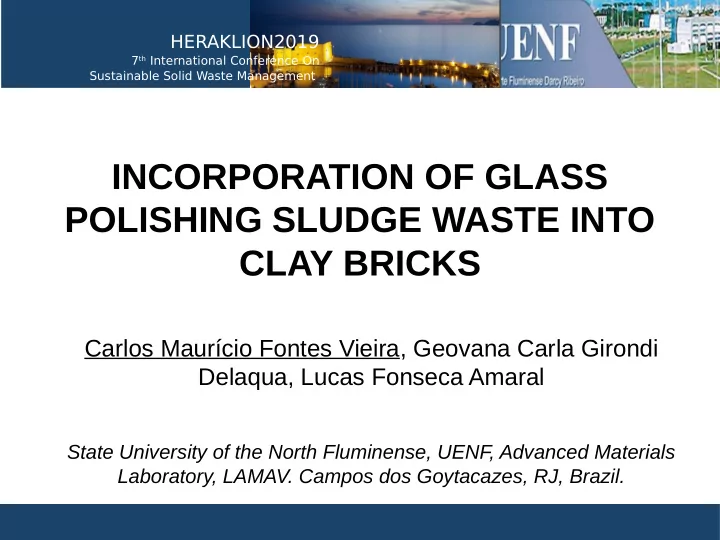

HERAKLION2019 7 th International Conference On Sustainable Solid Waste Management INCORPORATION OF GLASS POLISHING SLUDGE WASTE INTO CLAY BRICKS Carlos Maurício Fontes Vieira, Geovana Carla Girondi Delaqua, Lucas Fonseca Amaral State University of the North Fluminense, UENF, Advanced Materials Laboratory, LAMAV. Campos dos Goytacazes, RJ, Brazil.
The incorporation of wastes into clay ceramics , such as bricks and roofing tiles, envolves some advantages: 1. Recycling the waste as a sub-product with possible inertization of toxic and dangereous elements; 2. Saving of clayey material that is a non-renewable resource; 3. Enhancing the ceramic processing and the quality of the fired product and saving energy.
One type of industrial waste is that generated during the processing (benefiting and transformation) of common soda-lime flat glass. In particular, the sludge from the final polishing stage, after cutting the glass plate. Waste generation process Polishing Clear Sedimented Stirring tank process water waste Pumping Resultant indution Water + glass Decantation Filter press waste reservatories Ducted Pumping induction indution Final product Submersible Reservatory pump tanks Machine to lapidate four sides of Pumping the glass plates at the same time indution
OBJECTIVE The objective of this work was to evaluate the technological properties of a kaolinitic clay used to fabricate heavy clay ceramic products, such as bricks and roofing tiles, incorporated with glass polishing waste fired at 900 and 1000°C.
MATERIALS AND METHODS Raw Kaolinitic Glass Polishing Waste Materials (GPW) Clay Formulations 0, 10, 20, 30 and 40 wt.% GPW Forming Uniaxial pressing at 20 MPa, rectangular specimen 114x2.5x1 mm Drying at 110 o C Firing Laboratory Physical and furnace Mechanical at 900 and 1000 o C Properties: Fired Water absorption specimen Flexural rupture strength
Chemical composition in terms of oxide (%) of GPW and clay SiO 2 Na 2 O Al 2 O 3 Fe 2 O 3 K 2 O SO 3 TiO 2 ZrO 2 Cr 2 O 3 P 2 O 5 CaO MgO NiO LoI GPW 67.88 13.57 8.44 2.44 2.31 1.25 0.30 0.25 0.17 0.11 0.10 0.09 0.05 2.80 49.45 0.34 0.29 0.39 31.31 1.44 3.26 - 1.88 - - - - 14.75 Clay
Particle size distribution of the glass polishing sludge and clayey body
Extrusion prognosis of the formulations through Atterberg plasticity
Optical dilatometry of glass polishing sludge
Water absorption and mechanical strength of the ceramics as a function of the amount of incorporated GPW 26 Flexural rupture strength - FRS (MPa) 16 o C Bricks 900 Water Absorption - WA (%) 24 o C 1000 14 o C 900 22 o C 1000 12 20 10 Roofing tiles 18 8 Roofing tiles 16 Bricks 6 14 4 Massive bricks 2 12 0 10 0 10 2 0 30 40 0 10 20 30 40 Waste (wt. %) Waste (wt. %)
CONCLUSIONS • The incorporation of a glass polishing sludge, generated as a waste in a glass processing industry, into clay ceramics fired a 900 and 1000°C caused substantial improvements in their technological properties; • The chemical composition of the waste is typical of a soda-lime glass with high amount of fluxing elements that form liquid phase in a temperature range typical to obtain bricks and roofing tiles, contributing to reduce the porosity of the ceramic; • The waste has an appropriate particle size to be used in clay ceramics body, also acts as a non-plastic material, adjusting the elevated plasticity of the clay; • The temperature exercises a strong influence on the evaluated properties, making possible an increase in the mechanical strength, as well as a reduction in the water absorption of clayey ceramic; • The studied waste can be recycled into clayey ceramic products, assigning economic value and leading benefits to the environment by avoiding its disposal in landfills.
HERAKLION2019 7 th International Conference On Sustainable Solid Waste Management Acknowledgements The authors thank the Brazilian agencies: CNPq, CAPES and FAPERJ for supporting this investigation as well as to Viminas firm for providing the waste.
HERAKLION2019 7 th International Conference On Sustainable Solid Waste Management THANK YOU! vieira@uenf.br
Recommend
More recommend